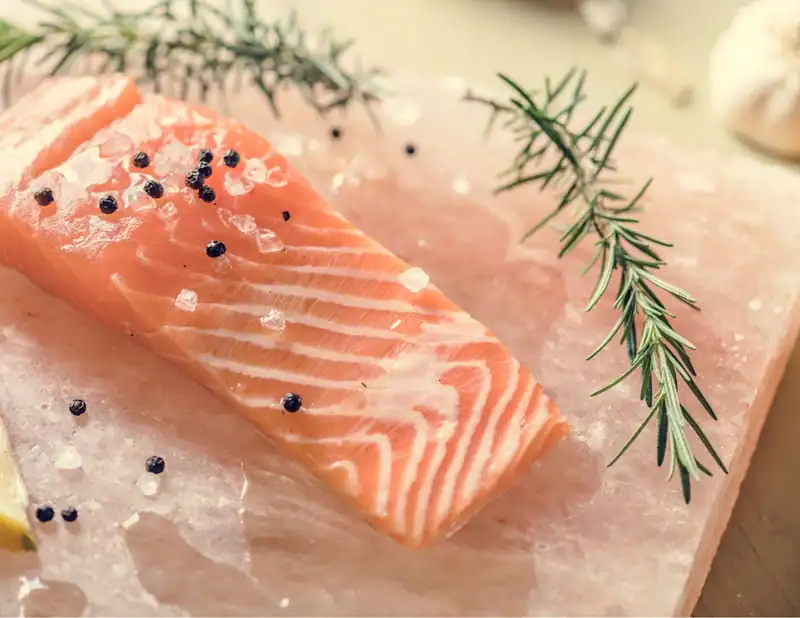Cooking fish on a Himalayan salt block is an innovative and healthy way to add flavor and sophistication to your seafood dishes. This cooking method has gained popularity in recent years due to its ability to bring out the natural flavors of the fish while also imparting a subtle saltiness.
In this article, I’ll dive into the benefits of cooking fish on a Himalayan salt block and provide tips and tricks for achieving the perfect cook. By the way, if you were wondering where this big block of salt gets it’s pink color, be sure to see Why Is Himalayan Pink Salt Pink: Exploring The Exotic.
Can You Cook Fish On a Salt Block?
Salt blocks provide a unique cooking surface that imparts a delicate and subtle salt flavor to the fish, enhancing its natural taste and texture. When cooking fish on a salt block, it is important to use high-quality, fresh fish for the best results.
If you normally prefer to pan fry your fish, you can turn on your stovetop or grill and preheat the salt block until it reaches a desirable temperature. Now you will just use the salt block as if it is the pan surface. You may want to apply a thin coating of cooking oil on the salt block, then carefully lay your fish skin-side down on the heated surface and allow to cook for several minutes until its crisp exterior is golden brown.
If you normally prefer to bake your fish, the salt block can be used instead of a pan or cookie sheet. Since the salt block is heavy, I like to use the type that comes with a metal rack for baking. That way you get a sturdy handle to grab on each side of the block to move it in and out of the oven. Place the salt block on the middle rack of your oven while it is still cold. Apply any cooking oil now because it is simpler to do when cold. Then preheat the oven to the right temperature for the fish, but not higher than 450 degrees Fahrenheit (235 degrees Celcius). Once the oven is preheated, place your fish skin side down on the prepared salt block, set a timer for an appropriate cooking time for the type of fish and thickness of the cut.
It’s not necessary to remove the salt block from the oven, unless you want to serve the fish on the block. Note that the block will be hot, so things will continue to cook. I just like to remove the fish from the salt block and let it cool down slowly with the oven.
Fish cooks quickly when placed upon a salt block so be vigilant in not overcooking it! You can always test doneness by pressing lightly onto the top of the fillet, cutting through a section or using an instant-read thermometer.
Tips For Cooking Fish On A Himalayan Salt Block
Cooking fish on a Himalayan salt block is an easy, healthy way to prepare your favorite seafood. Not only does it impart a subtle salt flavor, but it also helps to naturally season the fish without any added salt or oil. Here are some tips for getting the most out of cooking with salt blocks:
- Use High-Quality Fish – Use high-quality, fresh fish for the best flavor and texture when cooking on a salt block.
- Thoroughly Dry Fish – Before cooking fish on a Himalayan salt block, make sure it is thoroughly dried to prevent sticking.
- Season the Fish – Season the fish with salt, pepper, and herbs, or marinate it for added flavor. Some cooks like to use some cooking oil on the fish before applying their seasoning.
- Heat the Block First – Preheat the salt block on the stovetop, grill or oven until it reaches the desired temperature. Pre-heating the block slowly can extend the life of your block.
- Cook Skin-Side Down – Place the fish skin-side down on the salt block and cook until the skin is crisp and golden brown.
- Avoid Overcooking – Fish cook quickly on a salt block, so be careful not to overcook. Check for doneness by gently pressing on the fish, cutting a section, or using a meat thermometer.
- Use a Fish Spatula – Use a fish spatula to flip the fish, as it will be delicate and may break apart if handled roughly.
- Let it Rest – After cooking, let the fish rest on the salt block for a few minutes to allow the flavors to settle and the juices to redistribute.
- Clean the Block – Once the salt block completely cools down, clean it with a brush and a dry cloth after cooking, avoiding soap or water. If you have something sticky on the block, take a paper towel, wet it, then squeeze it out and use it to clean the area.
- Serve on the Block – The salt block will keep the fish warm, so you can serve it directly on the block for an attractive presentation. Remember though that the fish continues to cook while it is on the salt block.
What Are The Best Types Of Fish To Cook On A Himalayan Salt Block
Many types of fish can be cooked on a Himalayan salt block, but some are better suited to this method of cooking than others. The best types of fish to cook on a salt block are those that have a delicate flavor and a tender texture, as the salt block can enhance the natural taste of the fish while preserving its moistness. Recipes that completely season or ‘encrust’ the fish with herbs, spices, Panko or other dry coatings work well with a salt block because they help keep the fish from sticking to the block, yet they allow the crust to pick up the unique salty flavor from the salt block.
Some of the best fish to cook on a Himalayan salt block are types that are not too oily but not too thin and dry. Ideas include:
- Salmon
- Trout
- Halibut
- Sea Bass
- Cod
- Tilapia

When cooking fish on a salt block, it is important to use high-quality, fresh fish for the best flavor and texture.
The salt block can also be used to cook fish that has been previously marinated, as the salt can help to lock in the flavors of the marinade.
How Long Does It Take To Cook Fish On A Himalayan Salt Block?
As a general guideline, most fish will take about 4-6 minutes to cook on each side on a preheated salt block. The thickness of the fish, the temperature you’ve preheated the salt block, and the desired degree of doneness will vary this time.
Thick-cut fish portions might require more time to cook, but if you’re dealing with thinner cuts of fish, they can be cooked in only 2 – 3 minutes per side. Also remember that good quality fish only needs to have the surface throughly seared – and it is not necessary for the interior to be cooked through. Everyone has there own notion of how much cooking is enough, but overcooking will dry out your meal.
In general, your fish cooking times on a salt block are going to be very similar to cooking times for using regular frying, grilling or baking methods.
It is also important to note that cooking fish on a salt block can produce a more intense and flavorful result than traditional cooking methods. The salt from the block can penetrate the fish, enhancing its natural taste and helping to lock in its moisture. This makes it easy to achieve perfectly cooked, juicy, and delicious fish every time you cook on a Himalayan salt block.
If you’d like to try out cooking your fish on a Himalayan Salt block, here is a smaller block that I can recommend. Smaller means that it’s not as heavy as some of the other choices and it comes with a convenient metal rack with handles.
This Pink Himalayan Salt plate is 12" x 8" x 1.5" and is designed for cooking or baking. The plate comes with a perfectly sized metal rack to hold the salt block and gives you two handles so that you can more easily remove it from an oven rack or grill when your food is hot.
Can I Cook Other Types Of Seafood On A Himalayan Salt Block Besides Fish?
In addition to fish, the salt block can also be used to cook shrimp, scallops, and other types of seafood that you normally fry, grill or bake. The salt block imparts a subtle salt flavor to the seafood, enhancing its natural flavor and adding a touch of elegance to the dish. Note that you will not get any charing as you do on a grill, so salt blocks are not preferred for recipes that depend on that charred flavor or surface finish.
How Do I Clean A Himalayan Salt Block After Cooking Fish On It?
In general, to clean your salt block after cooking fish, you will want to allow the block to cool completely on a heat-resistant surface, remove residual foods with a brush, spatula or sponge, rinse briefly with warm water, and pat dry with a cloth or paper towel.
Once the block has cooled, use a stiff brush or a coarse sponge to remove any residual food particles or oils from the surface. You can also use a mixture of warm water to gently clean the block. If you feel like you must, a bit of mild dish soap can help remove oily residue, but get that rinsed off so that your food won’t taste soapy next time. Avoid using abrasive sponges or harsh cleaning agents, as these can damage the salt and affect its flavor.
Once you have finished washing the block, give it a thorough rinse with warm water and gently pat it dry using a soft towel or a paper napkin. Avoid using heat from your stovetop or microwave to speed up drying because this could cause the salt to become brittle and break easily. Instead, simply leave the block on an even surface in a low-humidity area so that air can naturally aid in its evaporation process. If you have a dish rack, that can help allow the salt block to air dry. Oh – and DO NOT try to wash a salt block in the dishwasher!
Pro Tip – Let your salt block cool down before cleaning, especially if you plan on rinsing with water, as the sudden temperature change can cause it to crack or become damaged.
Frequently Asked Questions
What is the best temperature to pre-heat a Himalayan Salt Block for cooking fish?
For optimum results, it’s best to pre-heat a Himalayan salt block slowly before cooking fish on it. It should reach 350-450°F for the fish to cook evenly and quickly while safeguarding against any cracking of the block itself.
If you are heating your salt block on either a stovetop or grill, allow 15-20 minutes for pre-heating the block. If you are using your oven, just go by the oven pre-heating signal. To extend the life of their salt block, some people like to first pre-heat to 250°F, and then raise the temperature to the final level to finish the pre-heating cycle.
How do I prevent fish from sticking to the salt block?
To ensure your fish won’t stick to the Himalayan salt block while it’s cooking, be sure you dry and season it completely before placing the fillet on the block. Preparations such as dry rubs and Panko breading work very well when cooking fish on a Himalayan salt block.
If absolutely needed, lightly oil or spray the fish with cooking mist. Don’t spray the salt block itself, and follow the cleaning instructions after your salt block has completely cooled to room temperature.
Can I reuse a Himalayan Salt block multiple times?
You can reuse your salt block for cooking fish multiple times but remember to clean it after each use and minimize using any oils or fats as this will cause residue to build up on the salt surface.
If you notice that the salt block is becoming cracked or has dark patches, it’s time to discard the salt block and get a new one. Never attempt to cook fish at extremely high temperatures (above 450°F) as this could damage your salt block. Save blackening or searing fish recipes for a cast iron skillet.
Can I cook frozen fish on a salt block?
No, always use completely thawed fish when cooking on a Himalayan salt block. There are two major reasons for this. Placing frozen fish on a pre-heated salt block can cause thermal shock – the fish will be okay, but it will accelerate cracking in your salt block. The other reason is that as the fish un-freezes, it can release a lot of extra moisture which is hard on the salt block, can cause sticking, and may cause the fish to pick up too much of the salty flavor from the block.
What if my salt block doesn’t come with a metal rack?
When cooking in the oven, the simplest thing to do is to set the salt block in a bigger baking pan or cookie sheet with edges. That gives you something to grab onto and it will slide on the oven rack better than the salt block will.
When cooking on a gas stovetop or grill, if you don’t have the metal rack, I find that the best policy is to not plan on moving the salt block while it is hot. Just turn off the heat and let everything cool down slowly. In this situation, you could also use the cooking sheet method. When cooking on an electric stovetop, you really need to get a metal diffuser or rack to use the salt block effectively.
Can I use the salt block on an induction cooktop?
No – salt blocks do not work well with induction cooking. Some manufacturers offer adaptors to use with induction cooking, but since I have not tried this method I cannot vouch for how well this might work.
Can I use the salt block cold to serve sashimi or smoked fish?
Yes! This is a terrific use for your salt block. Sashimi, lightly seared tuna, smoked fish such as salmon, or fishes that are preserved using salt (herring, anchovies, etc.) are all great choices for serving cold on a pre-cooled salt block.
All you need to do is to place the salt block in your refrigerator for 1 to 2 hours before serving. Don’t use your freezer (too cold > thermal shock) and don’t leave it in the ‘fridge too long because it can absorb too much moisture, leading to cracking.
Some people report serving Ceviche on their salt block, but beware that the citrus juices used in most ceviche recipes can accelerate disintegration of the salt.
Featured image and Salmon inset image by rawpixel.







